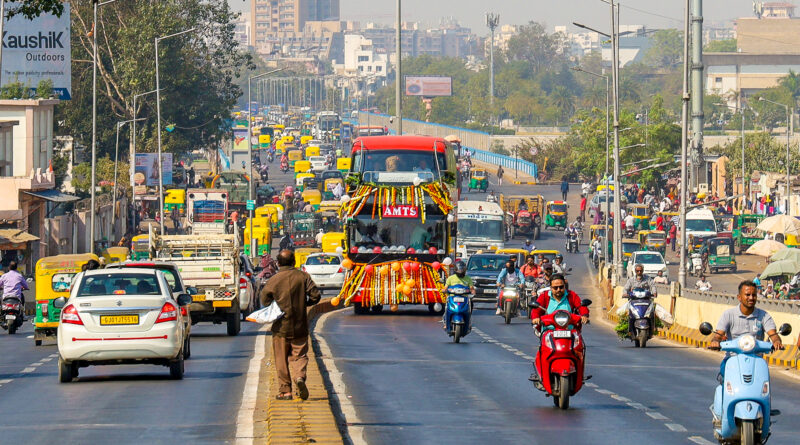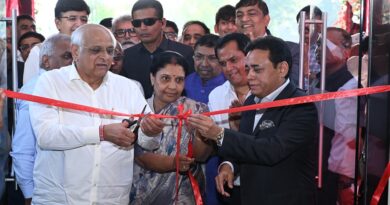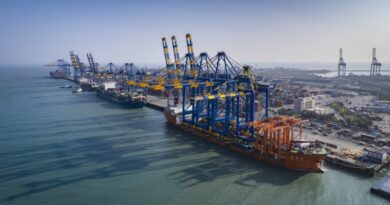AMTS brings the nostalgic feel back…Old and younger Genz thrilled to see Double Decker on Ahmedabad Roads
BILKULONLINE
Ahmedabad, Feb 4: People of Ahmedabad were thrilled to see double-deckers on the roads of Ahmedabad city on Saturday.
AMC-run Ahmedabad Municipal Transport Service (AMTS) has purchased 7 double-decker buses in the first phase for Rs. 6 crore on an experimental basis. Each bus has a seating capacity of 65 passengers, with 29 seats on the lower deck and 36 on the upper deck.
Sarika and Tahira two friend who were walking on the Ashram Road said “today we saw the double decker and were thrilled to have a look of it. We want to soon sit and commute in it with other friends to get that feel and experience !”
When the double-decker was moving on the Paldi road on Saturday evening in Ahmedabad, people were amused and happy to see it. It looked like a new bride with decorated look in a red attire !
The newly inaugurated double-decker bus AMTS runs on the road after the inauguration by Ahmedabad Municipal Corporation (AMC) in Ahmedabad on Saturday (photo on top)
History & Background:
- Ahmedabad is well known among ancient cities of India. Ahmed Shah, ruler of Gujarat in those days established this city in 1411, hence it was named as Ahmedabad, and with the passage of time it became famous as Ahmedabad. There is a saying about the birth of this city: “Jab kutte par Sassa aayaa, Tab Badshah ne shahar basaayaa”. (When the rabbit attacked the dog, the Sultan populated the city)
AMTS is India’s largest Municipal Transport Service for local conveyance. It is a voluntary service managed by Ahmedabad Municipal Corporation under Bombay Provincial Municipal Corporations Act. Amdavad Municipal Transport Service (AMTS) runs the public bus service in the city of Amdavad. The responsibility of the administration of AMTS comes under the Amdavad Municipal Corporation.
(Now called Amdavad by the AMC)
AMTS TIMELINE
There is continuous hike in population vis-à-vis the industrial development. The walled area of the city experience congestion of population and with that the jurisdiction of municipality also expanded. Reference from AMC records suggests that the housing societies and colonies had been started in the surrounding areas in order to reduce the density somewhere in 1940. Leading citizens, lawyers, labour leaders, industrialists and traders were elected as municipal members in those days. Manibhai Chaturbhai Shah was the municipal President. Dr. A.N.Tankaria was the Vice-President and Navinchandra Desai was standing committee Chairman. Moreover Nandlal Bodiwala, Arjunlal Bhogilal Lala, Dolatram Umedram Shah and Dadubhai Amin were among municipality members. They were concerned about the welfare of the citizens and the ideals of the social workers in that generation were very high with warm feelings for the society. They were vigilant for the well-being of the city. The very first resolution was passed by the municipality on 10th June 1940 in the General Board meeting (to begin transport services vide Resolution No. 476 dated 10-6-40). This task was put on the board by the standing committee (vide committee Resolution No. 878 dated 4-6-1940)

According to the said resolution, it was decided to form a special committee vide Section No.38 of municipal Bureau Act. The jurisdiction of the committee was to get the sanction of state government to acquire loan amount necessary for the bus project, and to map out various bus-routes in different areas of the city. Main purpose of the transport service was to avoid the population density in city area and thereby to provide affordable means of transportation facility for the citizens staying far from the main city area. The profit motive was not there at all at any stage. The decision was to start transport facility first in the municipal boundary. For that purpose they had to contact Provincial Motor-transport Controller and Regional Transport Authority in Gujarat in order to obtain necessary licence valid upto 31-3-1941. The committee was comprised of 7 members including Arjunlala, Nandlal Bodiwala, Navinchandra Desai, and Dadubhai Amin.
The committee formed in June 1940 presented its plan to the General Board on 21st August, 1940 vide Resolution No.1161 dtd.21-8-40. The Board resolved in addition that the plan should be sanctioned by R.T.A. and it should permit to manage the bus-routes mentioned in the resolution for five years. If the R.T.A. proposes to increase number of Bus-routes, or if the municipality thinks so by its experience, more routes will be added. Other areas such as Naroda , Vasana, Sabarmati Hansol etc. also will be provided with the service if the need arises, and due approvals will be obtained from Commissioner of Northern region as per municipal Burro Act. If the municipality does not get such approval, and some other organisation obtains the same, RTA must clarify that such organisation will not allow the passengers within municipal limit to use the facility of transport.
The President of the committee was authorised to make any alterations in the plan if required. Municipal Chief Officer was empowered to apply for the stage carriage permit and to pay the fees, expenses etc. for that purpose. The President was also empowered to make necessary arrangements for the public loan amount to Rs.14,00,000 with the rate of interest at 4%.
In Oct.1940, as per General Board Resolution No.1640 dtd.24-10-1940, the committee was authorised to purchase buses from the licenced manufacturers at the market-price suggested by arbitrator, and municipal corporators were duly given power to take necessary steps in this aspect.
No concrete steps seem to have been taken till 1946, after the above sanctions in the subject of starting municipal transport service. Probably some difficulties might have been raised from the licenced manufacturers or the delay in Government decisions against the execution of this plan.
Thereafter this topic was discussed many times, and in November 1949, the old plan prepared by the Bus-Committee was passed (with Resolution No.800 dtd.16-11-46). It was suggested that the plan should be proposed properly to the Transport Minister of Mumbai State through the President who can forward it and discuss it systematically. The Board also approved to collect loan amt. Rs. 25 lacs as a cost of transport project. The proposal was put forth by the first president Dr. A.N.Tankaria who was also appointed later as a chairman of bus-committee, the proposal was supported by Ram Prasad Contractor. Moreover the decision was taken to obtain monopoly in the subject of plying the buses within the municipal areas as well as in Sabarmati, Vasana, Naroda, Odhav and Sadar Bazaar. It was also decided to get approval from Government of Mumbai to float a long term loan for 30 years at 3% interest rate in Feb/March 1947 for this project. There was a firm decision this time to start the transport service, and the committee got a wider authority, so that they can make their best effort enthusiastically to complete it. They constantly contacted government officers, ministers and influential people. Public opinion was developed in favour of starting the public-bus, therefore the government was impelled to take a quick decision. Bus-fare was kept as 1 (one) Anna minimum and 3 Annas maximum and the fact was informed to R.T.A. office through the chief officer.
During this time, resolution No-275 dated 23-5-46 was passed to take expert services of G.L. Sheth (ICS) in the municipality. He has played a great role to initiate bus-services. He also helped in taking quick administrative decisions, and guiding in routine jobs to the committee. His enthusiasm and talent were very much helpful to start the services.
Resolution No.358 dated. 4-6-46 was passed in response of the proposal made by Arjun Lal, and it was bifurcated in two parts:
(1) People should be convinced to build residential units on the open plots situated outside the city, to reduce the population density. However this was difficult in the absence of proper transport facility, therefore the Board resolved that monopoly right should be vested with the municipality to ply petrol or diesel buses and electric trolley service. The Board also requested Mumbai Government to make changes in the present laws if the need arises.
(2) The Board also resolved to rethink the 1940 plan or to fabricate all new plan, keeping in view the growing population, and form a new committee, that can invite the experts for their advice, and necessary expenses should be made for the project.
Committee members:
(1). Dr. A. N. Tankaria – Chairman
(2). Chinubhai Chamanlal
(3). Chaitanya Prasad M. Diwanji
(4). Ramprasad Chandulal Contractor
(5). Krishnalal T. Desai
(6). Arjunlal Bhogilal Lala
(7). A. S. Sheikh
(8). Sir Mehboobmiya Imanbaksh Kadri
(9). Keshavji Ranchhodji Vaghela
Important Service of AMTS:
HIRE A BUS
AMTS offers facility for marriage, death event, picnic etc. at existing rates to the common people. The registration of the bus can be made at the office of Traffic General Section, Jamalpur.
CONCESSION SCHEMES
The Corporation provides concessions on its fares &/or free travel facilities on it’s buses to various categories of citizens. The concessions/free travel applicable to different category. Details of these categories can be sought from AMTS office of its official website.




